Related Research Articles
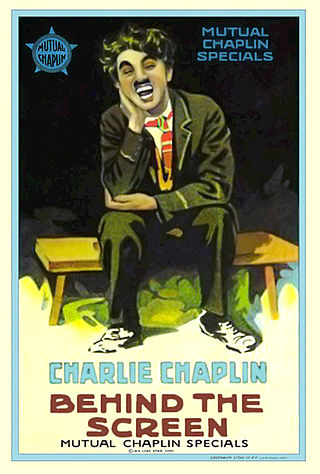
Behind the Screen is a 1916 American silent short comedy film written by, directed by, and starring Charlie Chaplin, and also starring Eric Campbell and Edna Purviance. The film is in the public domain.

Salomé is a 1918 American silent drama film produced by William Fox and starring actress Theda Bara.
The Oath of Pierre is a 1914 American silent short film directed by Sydney Ayres starring William Garwood and Charlotte Burton. The film was based on a story by M.H. McKinstry.The film was presented as having 2 reels and having been "enacted in primeval forests".

Daniel Sydney Ayres(August 28, 1879 – September 9, 1916) was an American silent film actor, director and screenwriter. Ayres was also a theater actor.

Back to the Farm is a 1914 silent comedy short film produced by the Lubin Manufacturing Company and co-starring Oliver Hardy and Bert Tracy. It is the earliest Hardy film known to survive.
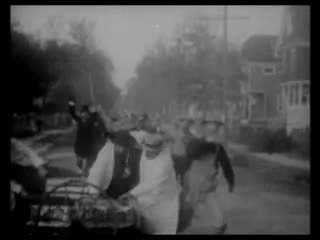
The Curtain Pole is a 1909 American comedy film directed by D. W. Griffith. A print of the film still exists. The film was made by the American Mutoscope and Biograph Company when it and many other early film studios in America's first motion picture industry were based in Fort Lee, New Jersey at the beginning of the 20th century.
A Rowboat Romance is a 1914 American short comedy film directed by and starring Fatty Arbuckle.

Old Wives for New is a 1918 American silent drama film directed by Cecil B. DeMille. It is based on the 1908 novel of the same title by David Graham Phillips.

The Trail of Hate is a 1917 American silent drama film that portrayed the military exploits and personal rivalries of two United States Army officers stationed in the American West and later in the Philippines. The production starred John Ford, who at that time was credited as "Jack Ford". Currently classified as a lost film, this two-reel short is identified by some biographers of John Ford and in many filmographies, both in print and online, to be his second release as a director. He is also credited in various sources for writing the film's screenplay or "scenario". Other Ford biographers, however, most notably American director and film historian Peter Bogdanovich, credit this production's screenplay and its direction to John's older brother Francis Ford.
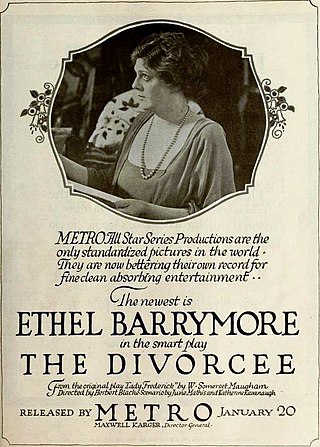
The Divorcee is a 1919 American society drama starring Ethel Barrymore in her last silent feature film. The film is based on a 1907 play, Lady Frederick by young Somerset Maugham, which had starred Barrymore on Broadway. The play was already quite dated when this film was made, but the actress was always comfortable with this kind of soap-operish melodramatic material. Herbert Blaché directed, and June Mathis wrote the scenario based on Maugham's play. The film was produced and distributed by the Metro Pictures company.
Beau Brummel is a 1913 silent short film directed by and starring James Young in the title role. Presumed now to be lost, it was produced in Brooklyn, New York, by Vitagraph Studios and also featured in its cast Clara Kimball Young, Rex Ingram, Julia Swayne Gordon, and Etienne Girardot. The photoplay's scenario was adapted from the Clyde Fitch novel and play, and upon the film's release Vitagraph listed it as a 1000-foot "one-reeler", which at the time would have had a maximum running time of 15 minutes.
The Cheese Special is a 1913 American silent short comedy film featuring Max Asher and marking the film debut of Louise Fazenda. The scenario was written by Allen Curtis, but the identity of the director is unknown. It was the first production released by the newly formed Joker productions, as part of the Universal Film Manufacturing Company. The film is presumed to be lost and there is no published synopsis of the film. Known production details state that it was shot on a beach resort and used a miniature train. The film had a wide release and was reviewed by The Moving Picture World as a low comedy suited for the burlesque theaters.
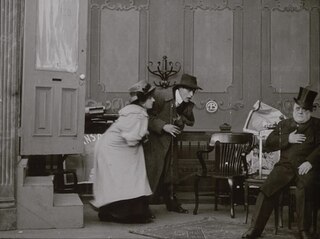
Her First Biscuits is a 1909 American silent short comedy film written by Frank E. Woods, directed by D. W. Griffith, and starring John R. Cumpson and Florence Lawrence. At its release in June 1909, the comedy was distributed to theaters on a "split reel", which was a single projection reel that accommodated more than one motion picture. It shared its reel with another Biograph short directed by Griffith, the drama The Faded Lilies. Prints of both films are preserved in the film archive of the Library of Congress.
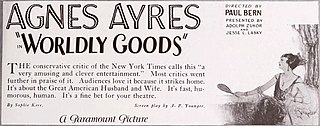
Worldly Goods is a 1924 American silent comedy film directed by Paul Bern and written by Sophie Kerr and A. P. Younger. The film stars Agnes Ayres, Patrick H. O'Malley, Jr., Victor Varconi, Edythe Chapman, Bert Woodruff, Maude George, and Cecille Evans. The film was released on November 24, 1924, by Paramount Pictures.

The Girl Spy Before Vicksburg is a 1910 American silent film produced by Kalem Company of New York and shot at the company's "winter studio" in Jacksonville, Florida. Directed by Sidney Olcott, the Civil War drama stars Gene Gauntier, Robert Vignola and JP McGowan. Gauntier, in addition to performing as the production's title character, is credited with writing its storyline or "scenario".
The Albuquerque Film Manufacturing Company, also known as the Albuquerque Film Company, was a film company established in New Mexico and soon after reincorporated in Los Angeles during the silent film era. Gilbert P. Hamilton was its president. It was established in 1913 and is known for the 3-reel westerns it produced. They were written by and star Dot Farley. Milton H. Fahrney directed. It also operated in Los Angeles in 1915 before going bankrupt in 1918. The company released its Luna branded films through United Film Service.
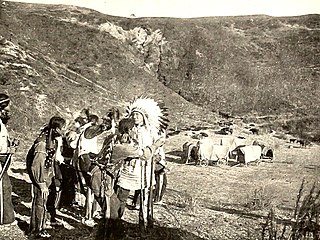
War on the Plains, also called Across the Plains, is a 1912 American silent short Western film directed by Thomas H. Ince and starring Francis Ford, Ethel Grandin and Ray Myers. It was produced by Bison Motion Pictures, a subsidiary of the New York Motion Picture Company. The film was made at Inceville, Santa Ynez, California.

For the Cause of the South is a lost 1912 American silent film that portrayed a tragic, fictional romance set during the American Civil War. Directed by Bannister Merwin, the film was produced by Edison Studios, which was located in New York City, in The Bronx. The production starred Laura Sawyer, Benjamin Wilson, and Charles Ogle, with supporting characters played by Bessie Learn and James Gordon in the role of Confederate General Robert E. Lee.

An Old-Time Nightmare is a lost 1911 American silent comedy-fantasy film. Directed by Fred Walton, the short was released as the latter half of a 1000-foot "split reel", with the first half being another comedy short, Lost in a Hotel. Both films were produced by the Powers Moving Picture Company of New York. This short's performers are not credited in 1911 reviews, in plot summaries, or in advertisements published in trade journals at the time. The faces of most of the cast were not visible on screen, for many of the actors wore costumes with full head coverings sculpted to resemble various species of birds, including a sparrow, eagle, dove, owl, wren, stork, bluebird, robin, linnet, and crow. While the short was identified upon its release as a comedy, it was also characterized in several contemporary reviews as a morality lesson and ideal photoplay for "juvenile" audiences.
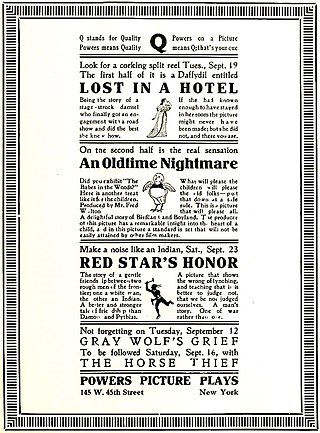
Lost in a Hotel is a 1911 American silent comedy film. It was released as the first half of a 1000-foot "split reel", with the latter half being the comedy-fantasy short An Old-Time Nightmare. Both films, currently presumed to be "lost", were produced by the Powers Moving Picture Company of New York. Neither the director nor the performers in this film are identified in 1911 reviews or in plot summaries and advertisements published in trade journals at the time.
References
- ↑ According to the reference How Movies Work by Bruce F. Kawin (New York: Macmillan Publishing Company, 1987, pp. 46-47), a full 1000-foot reel of film in the silent era had a maximum running time of 15 minutes. Silent films were generally projected at a "standard" speed of 16 frames per second, much slower than the 24 frames of later sound films. Also, most reels, especially the final reels in multiple-reel releases, were not filled to their maximum capacities.
- ↑ New York, Chalmers Publishing Company (1914). Moving Picture World (Jul-Sep 1914). Media History Digital Library. New York, Chalmers Publishing Company.